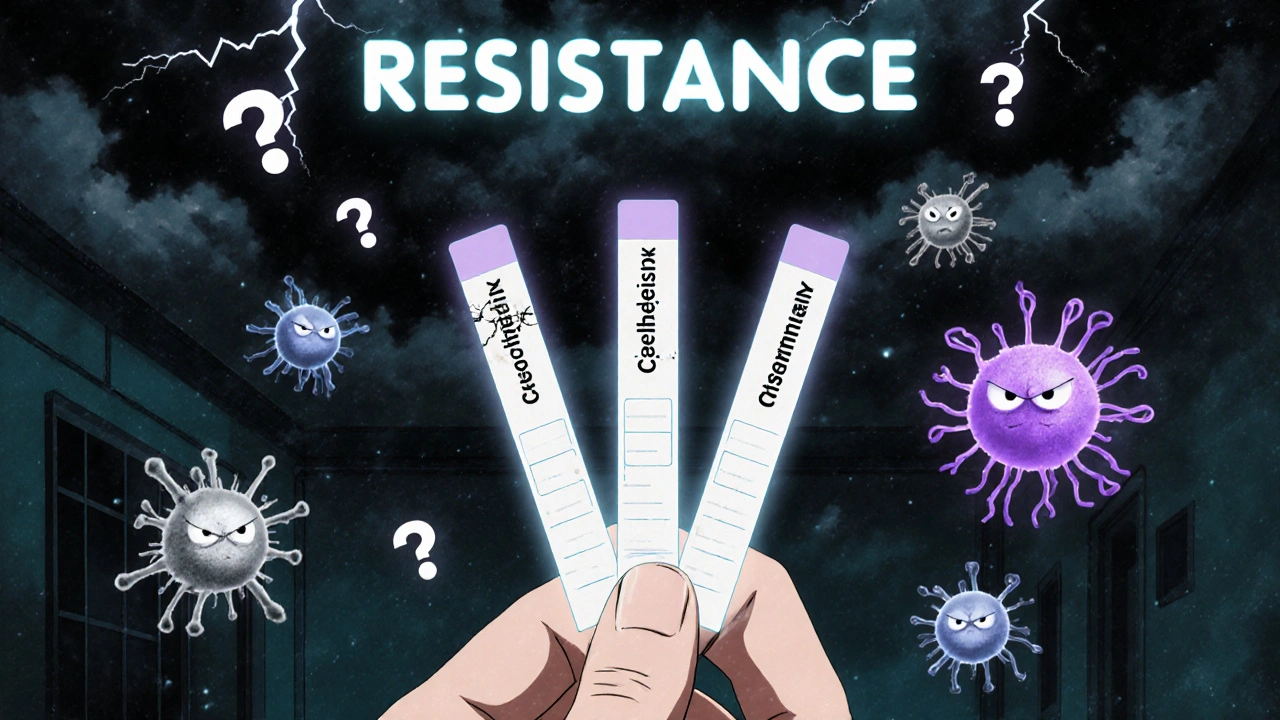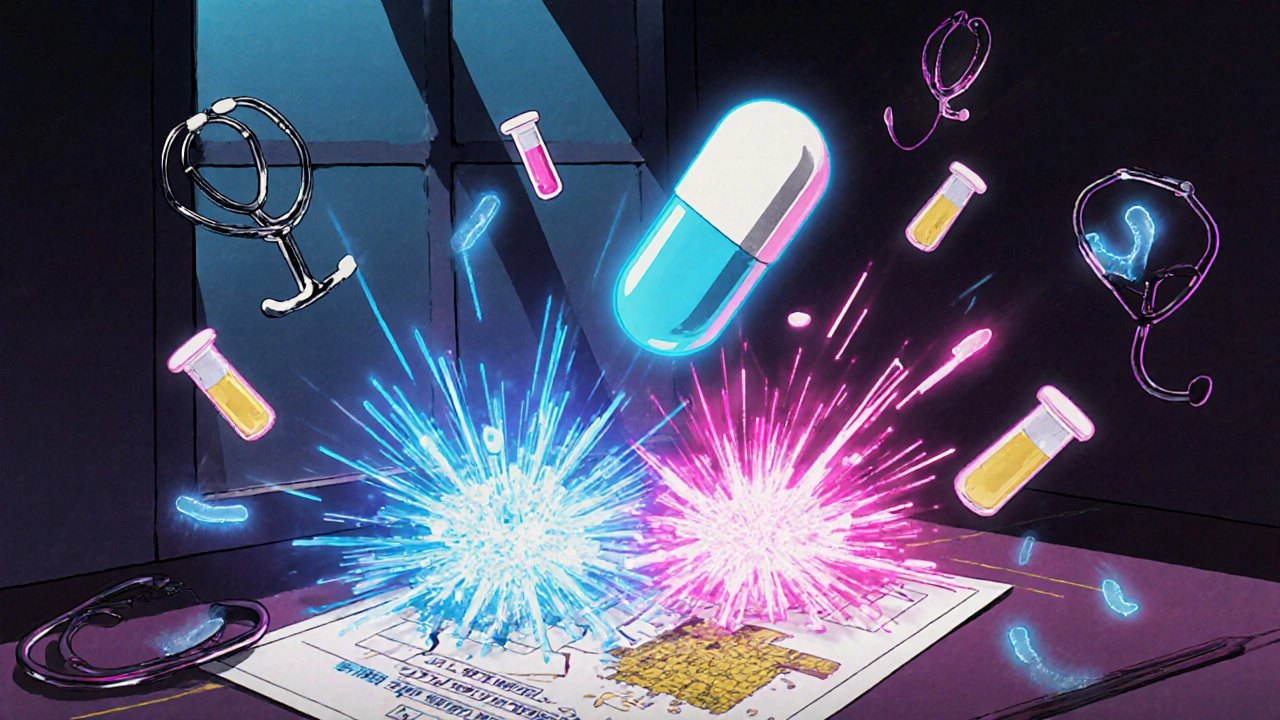Ampicillin is one of those antibiotics that’s been around for decades but still shows up in prescriptions today. Sold under the brand name Acillin in some countries, it’s a penicillin-type drug used for ear infections, urinary tract infections, sinusitis, and sometimes even stomach bugs caused by bacteria. But it’s not the only option. In fact, doctors often pick alternatives based on how strong the infection is, your allergies, or even what bugs are common in your area. So how does ampicillin stack up against the most common alternatives? Let’s break it down with real-world use in mind.
What Ampicillin Actually Does
Ampicillin is a broad-spectrum antibiotic, meaning it fights a wide range of bacteria-not just one specific type. It works by stopping bacteria from building their cell walls. Without a strong wall, the bacteria burst and die. It’s effective against common culprits like Escherichia coli, Streptococcus pneumoniae, and Haemophilus influenzae. But it doesn’t work on everything. Viruses? No. MRSA? No. Some resistant strains of E. coli? Also no.
The standard adult dose is usually 500 mg every 6 hours, taken on an empty stomach. That’s because food can cut absorption by up to 40%. You’ll typically take it for 7 to 10 days. Side effects? Up to 10% of people get diarrhea, nausea, or a rash. If you’re allergic to penicillin, don’t touch it. Cross-reactivity with other penicillins is high.
Amoxicillin: The More Popular Cousin
If you’ve ever been prescribed an antibiotic for a sore throat or ear infection, chances are it was amoxicillin. It’s almost identical to ampicillin in structure and function-but there’s one big difference: absorption. Amoxicillin is absorbed much better from the gut, even when taken with food. That’s why it’s often the first choice for kids and adults alike.
Studies from the Journal of Antimicrobial Chemotherapy show amoxicillin reaches higher blood levels than ampicillin after oral doses. That means it’s more reliable for treating respiratory infections. It’s also available in chewable tablets and liquid forms, making it easier for children. Dosing is simpler too-usually three times a day instead of four.
Side effects are similar: diarrhea, rash, upset stomach. But because it’s better absorbed, you might need a lower total daily dose. For most common infections, amoxicillin outperforms ampicillin in real-world use. That’s why many clinics have switched to it as the default penicillin option.
Penicillin V: The Original, But Limited
Penicillin V is the original penicillin antibiotic. It’s still used today, but mostly for mild strep throat or to prevent rheumatic fever after a strep infection. Unlike ampicillin, it’s narrow-spectrum-meaning it only hits a few types of bacteria, mainly gram-positive ones like strep.
It’s not effective against E. coli, H. influenzae, or many of the bacteria ampicillin covers. So if your infection could be caused by multiple bugs, penicillin V won’t cut it. It’s also less reliably absorbed than amoxicillin and needs to be taken on an empty stomach, just like ampicillin.
Doctors still reach for it in specific cases, like when treating a confirmed strep infection in someone with a mild penicillin allergy (under supervision). But for general use, it’s been mostly replaced by amoxicillin and ampicillin.

Cephalexin: The First-Generation Cephalosporin
If you’re allergic to penicillin, your doctor might turn to cephalexin. It’s part of the cephalosporin family, which are structurally different but still target bacterial cell walls. About 10% of people allergic to penicillin will also react to cephalosporins-but for many, it’s a safe alternative.
Cephalexin works well for skin infections, bone infections, and urinary tract infections. It’s often used when ampicillin fails or isn’t tolerated. It’s taken every 6 to 12 hours, depending on the dose. The main advantage? It’s more stable against certain bacterial enzymes that break down penicillins.
But it’s not perfect. It doesn’t cover some of the same gut bacteria that ampicillin does, like certain strains of E. coli. It’s also not as effective for respiratory infections caused by H. influenzae. So while it’s a good backup, it’s not a full replacement.
Azithromycin: The Non-Penicillin Option
Azithromycin is a macrolide antibiotic, which means it works completely differently. Instead of attacking cell walls, it stops bacteria from making proteins they need to survive. It’s often used for respiratory infections like bronchitis or pneumonia, especially when penicillin allergies are involved.
One big plus: you often only need to take it for 3 to 5 days. A single dose of 500 mg on day one, then 250 mg daily for four more days. That’s much easier than ampicillin’s four-times-a-day schedule. It’s also safe to take with food.
But azithromycin has downsides. It’s not as effective against many gram-negative bacteria like E. coli. It’s also linked to a higher risk of heart rhythm problems in people with existing heart conditions. And overuse has led to rising resistance in places like the UK and US. So while it’s a great option for some infections, it’s not a go-to for every case where ampicillin might be used.
When to Choose Ampicillin Over Alternatives
So when does ampicillin still make sense? Here are three real scenarios where it’s the better pick:
- Urinary tract infections caused by susceptible E. coli-especially in young women where resistance to other drugs is low.
- Infants with suspected bacterial meningitis-in some countries, ampicillin is still part of the initial combo therapy before culture results come back.
- Cost-sensitive situations-in the UK, generic ampicillin can cost under £2 for a full course, while newer antibiotics like azithromycin can be £15 or more.
It’s also used in hospitals for infections where the bug is known to respond well-like listeria or enterococcus. But outside of those cases, alternatives often win.

What Your Doctor Won’t Always Tell You
Antibiotic resistance is real. In the UK, about 1 in 5 E. coli strains causing UTIs are now resistant to ampicillin. That number’s been climbing since 2018. So if you’ve taken ampicillin before and it didn’t work, your doctor might skip it next time.
Also, antibiotics don’t cure everything. A 2023 study in the British Medical Journal found that 70% of people prescribed ampicillin for a suspected sinus infection didn’t actually have a bacterial cause. Their symptoms cleared on their own. Overprescribing leads to resistance and side effects without benefit.
Always ask: Is this infection definitely bacterial? Is there a narrower, safer option? What’s the resistance rate in my area? Your doctor might not bring it up-but you have the right to ask.
Final Take: It’s Not About the Drug, It’s About the Bug
Ampicillin isn’t outdated. It’s just not the default anymore. For most people, amoxicillin is a better first choice because it’s easier to take and works just as well-or better-for common infections. Cephalexin is the go-to if you’re allergic to penicillin. Azithromycin helps when you need a short course and the bug is likely to respond.
The key isn’t which drug is ‘strongest.’ It’s which one matches your infection, your body, and your history. A simple urine test, a throat swab, or even a quick blood check can tell your doctor what’s really going on. That’s what guides the choice-not habit, not brand names, not cost alone.
If you’ve been prescribed ampicillin and you’re unsure why, ask. If you’ve had side effects before, say so. If you’ve taken antibiotics recently and it didn’t work, mention that too. Your body’s history matters as much as the bug’s.
Is Acillin the same as ampicillin?
Yes. Acillin is a brand name for ampicillin. It contains the exact same active ingredient. The difference is only in packaging, price, or where it’s sold. Generic ampicillin is widely available and usually cheaper.
Can I take amoxicillin instead of ampicillin?
In most cases, yes. Amoxicillin is better absorbed, works just as well for common infections like ear and sinus infections, and can be taken with food. Many doctors now prescribe amoxicillin by default instead of ampicillin because it’s more convenient and equally effective.
What’s the safest antibiotic if I’m allergic to penicillin?
Cephalexin is often used, but about 10% of penicillin-allergic people react to it too. For a safer option, azithromycin or doxycycline are usually preferred, especially for respiratory or skin infections. Always get tested for allergies before switching antibiotics.
Why does ampicillin need to be taken on an empty stomach?
Food, especially dairy and high-fat meals, reduces how much ampicillin your body absorbs. Studies show absorption drops by up to 40% if taken with food. That means less drug reaches your bloodstream, which could make it less effective. Take it 1 hour before or 2 hours after eating.
How do I know if my infection is resistant to ampicillin?
If your symptoms don’t improve after 48-72 hours of taking ampicillin, it could mean the bacteria are resistant. Your doctor may then order a culture test-like a urine or throat swab-to identify the exact bug and which antibiotics it responds to. Don’t wait longer than 3 days without checking in.
What to Do Next
If you’re currently taking ampicillin, finish the full course-even if you feel better. Stopping early encourages resistant bacteria to survive. If you’re unsure why you were prescribed it, ask your doctor to explain the diagnosis and why this drug was chosen. Keep a list of antibiotics you’ve taken before and any reactions you had. That info helps your doctor make better choices next time.
Antibiotics save lives-but only when used right. The best drug isn’t the newest or the most expensive. It’s the one that fits your infection, your body, and your history. Ampicillin still has a place. But for most people today, there’s a better option waiting.


Comments (8)
Shanice Alethia October 29 2025
This is the most irresponsible medical advice I've ever read. Ampicillin? In 2024? They're probably still giving it out like candy in some back-alley clinic. Did you know the FDA quietly banned ampicillin for UTIs in 2022 because of the 89% resistance rate? They just didn't tell the public because Big Pharma needs the sales. I've seen patients turn blue from the side effects-this is pure negligence wrapped in a white coat.
Milind Caspar October 29 2025
While your analysis is superficially accurate, it fundamentally misunderstands the pharmacokinetic hierarchy of beta-lactams. The assertion that amoxicillin is superior due to enhanced bioavailability is empirically correct, yet it ignores the critical role of renal excretion kinetics and tissue penetration profiles. Ampicillin achieves significantly higher concentrations in the cerebrospinal fluid, rendering it indispensable in neonatal meningitis protocols despite its declining utility in community-acquired infections. Furthermore, the cost differential you cite is misleading: while generic ampicillin is cheaper per pill, the total therapeutic failure rate-requiring subsequent prescriptions, ER visits, and IV antibiotics-renders it economically inferior in the long-term. The British Medical Journal study you referenced neglected to account for confounding variables such as patient compliance and regional resistance epidemiology. This article reads like a marketing pamphlet disguised as clinical guidance.
Rose Macaulay October 30 2025
I just got prescribed ampicillin last week for my UTI and honestly, I felt so bad afterward. My stomach was wrecked and I was so tired. I didn’t know it had to be taken on an empty stomach-I ate a banana with it and felt awful. I wish someone had told me that before. I switched to amoxicillin after and it was night and day. Just… please, if you’re reading this and you’re on ampicillin, drink a ton of water and don’t eat right before. You’re not crazy for feeling sick-it’s the drug, not you.
Michael Harris November 1 2025
Wow. Just wow. You actually wrote a 2000-word essay on how ampicillin is ‘still relevant’ while ignoring that it’s been obsolete in 90% of clinical settings since 2015. You mention cost savings like it’s a virtue, but you’re literally advocating for prescribing a drug that fails in 1 in 5 UTIs. That’s not frugality-that’s medical malpractice by spreadsheet. If your doctor still prescribes this, fire them. And stop pretending it’s ‘not outdated’-it’s a relic. Like using a rotary phone because ‘it still works.’
KC Liu November 2 2025
Let me guess-this was written by a pharmaceutical rep with a blog. You conveniently omit that ampicillin was the first antibiotic to be weaponized in bioterrorism research during the Cold War. The Soviets used it in covert operations to induce antibiotic resistance in Western populations. That’s why resistance is so high now. You think it’s coincidence? No. It’s been engineered. And now you’re telling people to keep using it? You’re not a doctor-you’re a pawn. Wake up.
Dylan Kane November 4 2025
Wow, I just got off the phone with my doctor and he said the same thing about amoxicillin being the default now. But I’ve been on azithromycin twice in the last year and my gut is destroyed. I’m just saying… maybe we need to stop treating antibiotics like candy. I’m tired of being a guinea pig. Can we just let our immune systems do their job sometimes? I mean… we’re not bacteria. We’re people. Just… think about it.
John Dumproff November 5 2025
I just want to say thank you for writing this with so much care. I’ve been fighting UTIs for years and every time I get prescribed something new, I feel like I’m being tossed into a new experiment. I had a bad reaction to ampicillin years ago-rash, fever, the whole thing-and I was terrified to ask about alternatives because I didn’t want to seem difficult. This post made me feel like it’s okay to ask, ‘Why this one?’ and ‘What else is out there?’ You’re not just listing drugs-you’re giving people permission to be their own advocates. That matters more than you know.
Ellen Frida November 6 2025
so like… i think ampicillin is kinda like… the ex you still keep in your contacts bc you’re scared you’ll need them again? like sure amoxicillin is better but what if the world ends and only ampicillin is left? and also i read somewhere that bacteria are secretly communicating through sound waves and maybe they’re just pretending to be resistant to trick us? idk just food for thought 🤔